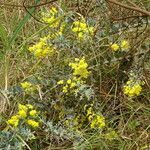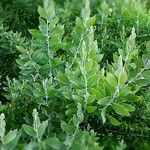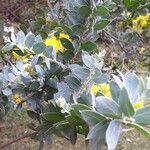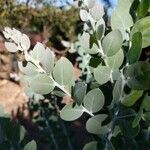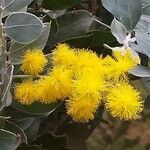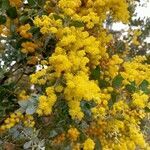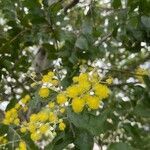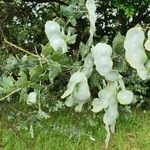Unarmed shrub or small tree up to 6 m high; young branchlets densely grey-pubescent. Leaves phyllodic, apparently simple, glaucous, mostly 1.5-4 x 1-2 cm, ovate to elliptic or elliptic-oblong, often oblique, with a single main longitudinal nerve and finely but distinctly penninerved, sparingly to densely pubescent, with 1 or 2 marginal glands. Inflorescences capitate, in axillary racemes which are usually longer than the phyllodes, mostly terminal. Flowers bright yellow; peduncles pubescent, up to 7 mm long. Calyx less than half as long as the corolla, pubescent apically. Petals ± free, hirsute. Pods brown, glabrous or pubescent, 4-8.5 x 1.5-2 cm, straight or almost so, flattened, margins often ± undulate, dehiscing longitudinally. Seeds dark brownish-black, 6-7 x ±3.5 mm, smooth, compressed; caruncle conspicuous; areole 3.5-4 x ±1.5 mm.
Unarmed tree to 5 m high. Branchlets glaucous, with dense, rigid hairs 0.4-0.6 mm, rarely glabrous. Phyllodes with dense straight hairs, sometimes glabrescent, elliptic or ovate, top acute, obtuse, or rarely retuse, mucronulate, sometimes slightly undulate, main vein closer to the dorsal margin, penniveined, 2-5 by l-2(-2.7) cm, 1.4-2.5 times as long as wide, pulvinus 1-2 mm, with a usually inconspicuous gland, (0.5-)0.8-2 cm above the base. Heads formed of 20-30 flowers grouped in racemes, with indumentum similar to that of the branchlets. Flowers yellow, pentamerous, bisexual. Pod flat with prominent margins, up to 9 by c. 2 cm, glaucous, sofdy hairy. Seeds longitudinal, 6.5-7.5 by 3-4 mm, pleurogram open, funicle thickened into a clavate aril.
An evergreen shrub. It grows to 3-5 m high and 3-4 m across. The stem is erect and slender. The bark is pale brown. The tree has a graceful weeping habit. The small branches have a bluish bloom and rigid hairs. The leaves (phyllodes) are silvery white. They are broad and oval with a single vein. They are 2-6 cm long and 1.5-3 cm wide. The flower heads are deep golden balls 1 cm across. They occur in large numbers in clusters. The flowering branches are 7-15 cm long. The flowers have a sweet smell. The pods are brown and flat. They are broad and wrinkled. They are 6-8 cm long by 2-2.5 cm wide.
Small tree or shrub, 3-6 m high. Branches: young ones and phyllodia covered with grey powdery bloom and dense grey hairs. Leaves phyllodia, apparently simple, silvery grey to dull green, velvety, ovate to elliptic, 15-40 x 10-20 mm, one prominent midvein. Flowers globular heads in axillary racemes, bright yellow. Flowering time June-Aug. Pod grey-brown, 30-80 x 15-20 mm, straight, velvety, margins flattened, wavy and constricted between seeds, apex acute, dehiscent.
Unarmed, evergreen shrub or small tree, 3-10 m, with branches and new growth covered with a greyish, powdery bloom and densely velvety hairs. Phyllodes oval or elliptical, with 1 central, longitudinal vein, silvery grey to dull green, Flowers in globose heads, bright yellow. Pods greyish brown, velvety, broad, with wavy margins.
Unarmed shrub or tree, up to 6 m high. Young branchlets and phyllodes densely grey pubescent, especially when young. Phyllodes ovate to elliptic, mostly 10-20 mm wide. Pods 15-20 mm wide. Flowers bright yellow.
Leaves glaucous, phyllodic, apparently simple, mostly 1.5-5.5 x 1-2.5 cm., ovate to elliptic or elliptic-oblong, softly ± pubescent.
Flowers yellow, in heads arranged in axillary racemes which are ± aggregated terminally.
Shrub or small tree 3-6 m. high, unarmed; young branchlets densely grey-pubescent.
